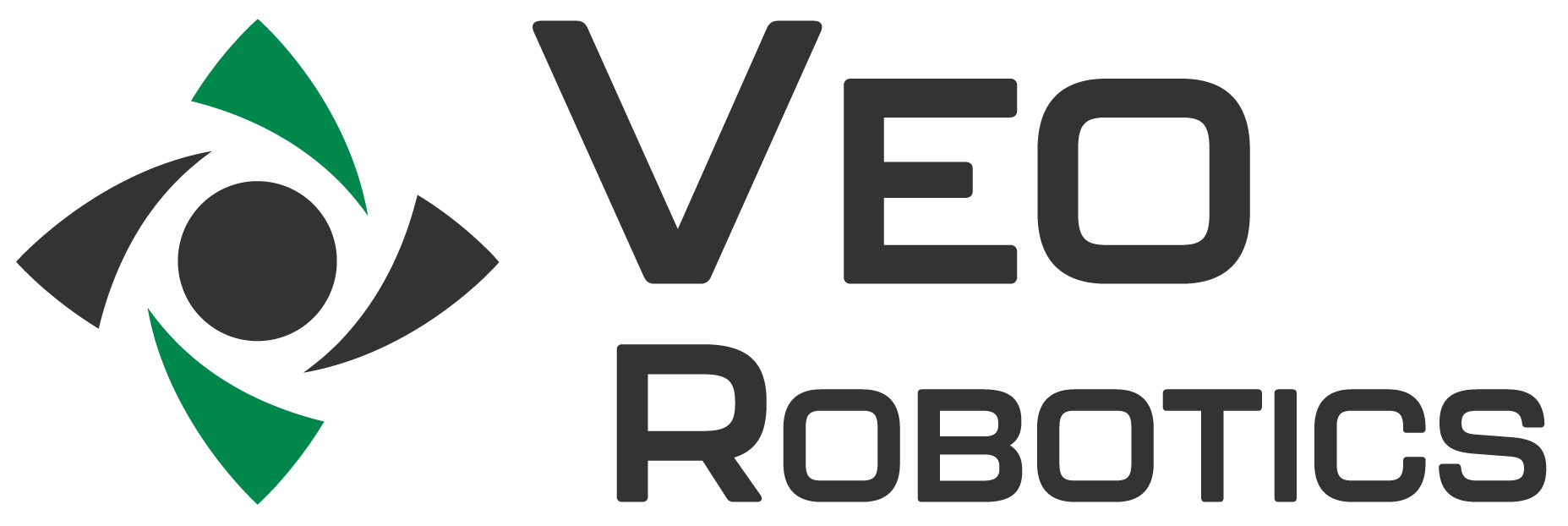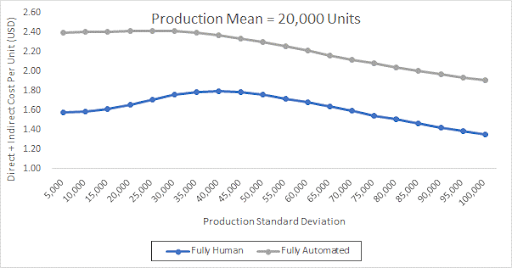To Automate, or Not to Automate? That Is the Question—Part 2
By Alberto Moel, Vice President Strategy and Partnerships, Veo Robotics
Dear reader, welcome back to our discussion about the value of flexibility in manufacturing. As we expounded in Part 1, although automation has its virtues, it is generally inflexible and only makes sense in production environments with low uncertainty (i.e., high certainty) around production volumes and product variability, and with sufficiently high production volumes to amortize any up-front investments in automation. On the other hand, going all-in on flexibility, using humans to respond to product or demand changes, maximizes the value of that flexibility at the expense of unit cost economics.
In other words, there is a tradeoff that depends on the uncertainty around product volumes. High uncertainty means it is possible you’ll end up making very few items, and automating is going to be uneconomic. But it also means it’s just as likely you’ll end up making many more units than expected, where automating is more economic than not, and if you hadn’t automated to start with, you’d be leaving money on the table.
As we saw in Part 1, the tradeoff point (in dollars and cents) is specific to a particular manufacturing process, but it can be easily evaluated using some simple tools.
Expected Unit Costs as a Function of Standard Deviation (Uncertainty) for Our Knuckle Assembly Example (Production Mean = 50,000 Units)
Let’s again revisit our canonical automotive knuckle assembly case study. In our initial analysis, we set up the following scenario: you’re expecting a production volume of around 50,000 units, but you’re uncertain as to how many you’ll actually need to manufacture. To decide whether or not to automate production, we considered the value of flexibility and estimated the expected cost per unit as a function of the standard deviation in units of production.
We concluded that flexibility (and having the option to be flexible) is valuable in many cases but simply not worth it in others. The tradeoff point is around a standard deviation of about 40,000 units: a production standard deviation below 40,000 units (still with an expected production of 50,000) tells us we’d be better off automating, while a standard deviation above the tradeoff point of 40,000 units suggests that fully manual is the most economic choice.
But what if the expected production volume is much higher or lower than 50,000 units? As you would predict, if the expected production volume is high (say, 100,000 units), the tradeoff point shifts towards automating, and manual assembly would only make sense if there’s a very high standard deviation due to high uncertainty.
Conversely, if the expected production volume is low (say, 20,000 units), manual assembly wins every time and even very low uncertainty would not justify the costs of automation.
Expected Unit Costs as a Function of Standard Deviation (Uncertainty) for Our Knuckle Assembly Example (Production Mean = 100,000 Units)
Expected Unit Costs as a Function of Standard Deviation (Uncertainty) for Our Knuckle Assembly Example (Production Mean = 20,000 Units)
You may be thinking now that this is all very well and good, but is there a way to make the system more “resistant” to uncertainty? Is it possible to eliminate the tradeoff between the two modes of production? The answer to both is, in fact, yes.1 As we discussed back in the original case study, with new human-machine collaboration technology,2 it is possible to reconfigure the process to make better use of the unique capabilities of both humans and machines.
As it turns out, such a rearrangement also has economic value. Redesigning the manufacturing process to optimize human and robot functionality beats both full automation and human-only assembly for a wide range of expected production profiles.
Human + Robot Process
Unit Costs as a Function of Expected Production With No Uncertainty
In other words, this new human + machine combination stochastically dominates the possible manufacturing modes of the past: fully human or fully automated. And because of the economic value the human + machine combination unlocks, there is no more tradeoff if the production profile is uncertain. For pretty much any uncertainty in production (as proxied by the standard deviation of production), the human + machine combination is the best choice.
In the case of an expected 50,000-unit production volume with high uncertainty, there is no reason to choose between fully manual or fully automated manufacturing processes. Instead, we can forge ahead and design our system to incorporate human and machine collaboration, knowing that it’s the best economic option regardless of how many units we end up producing.
Expected Unit Costs as a Function of Standard Deviation (Uncertainty) for Our Knuckle Assembly Example (Production Mean = 50,000 Units)
Margin Expansion and Margin Multiplier of Human + Machine Collaboration vs. Traditional Alternatives (Production Mean = 50,000 Units)
And the improvement in economics from using the human + machine collaborative solution is quite material. The cost improvements may look modest in the first chart above, but when considering the margin expansion or the margin multiplier on the original economics, it’s quite attractive. For example, in the second chart above you can see that the human + machine combination generates a margin expansion of between 20 and 25 percentage points over the fully automated solution (left axis). And if we assume a 10% cost-plus margin for the fully automated solution, this margin expansion effectively corresponds to more of a doubling of the margin (right axis). The expansion over the fully human solution is more modest, but economically meaningful.
Even if the expected production volume is much higher, you’d have to be much more certain of your production volume before committing to a fully automated solution. Hence, if you are uncertain about how uncertain you’ll be, it’s best to hedge your bets by optimizing for human and machine collaboration.
And if you are very uncertain about a low expected production volume, you lose nothing by optimizing for human + machine collaboration. The cost structure of the human + machine configuration is not very different from that of a fully manual system if production volumes are low.
Expected Unit Costs as a Function of Standard Deviation (Uncertainty) for Our Knuckle Assembly Example (Production Mean = 100,000 Units)
Expected Unit Costs as a Function of Standard Deviation (Uncertainty) for Our Knuckle Assembly Example (Production Mean = 20,000 Units)
In other words, flexibility and the option to be flexible introduced by human + machine collaboration are valuable—even more valuable than the flexibility of fully-human production. In our example, optionality is shown to be especially valuable in cases of high uncertainty regardless of production volumes, and still significantly valuable in cases of low uncertainty. This result applies in general: building flexibility into your production processes by making them safe for human and machine collaboration is almost always going to be the most cost-effective choice.
Using tools like the Veo FreeMove system, you will be able to automate the tasks that are most efficiently done by machines, while retaining the flexibility of human workers to manage tasks that require adaptability, dexterity, and judgment. Essentially, in plain English, you get the best of both worlds without sacrificing costs.
In the next part of this series, we will present another case study, this time about palletizing. Stay tuned!
1 Otherwise I wouldn’t be writing this blog post and doing the great reveal.
2 Such as the Veo FreeMove system, of course.









